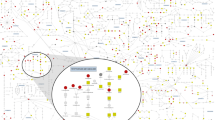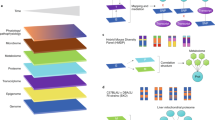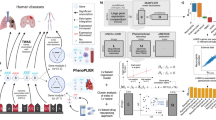Abstract
To apply genomic knowledge effectively in drug discovery, mechanistic connectivities between genetic variation and disease processes need to be established via systems biology approaches. Humans have hundreds of functionally specialized cell types that interact differentially with environmental factors to influence disease development and to modulate the effects of drugs. Metabonomics can provide a means of modelling these interactions, but the relationships between 'endogenous' metabolic processes (coded in the genome and intrinsic to cellular function) and 'xenobiotic' (foreign compound) metabolism are poorly understood, especially with respect to environmental factors. We present an overview of 'global' mammalian metabolic conversions that should be accounted for in human systems biology models and propose a new probabilistic approach to help understand gene–disease relationships and vexed issues of idiosyncratic drug toxicity.
This is a preview of subscription content, access via your institution
Access options
Subscribe to this journal
Receive 12 print issues and online access
$209.00 per year
only $17.42 per issue
Buy this article
- Purchase on Springer Link
- Instant access to full article PDF
Prices may be subject to local taxes which are calculated during checkout





Similar content being viewed by others
References
Hood, L. & Galas, D. The digital code of DNA. Nature 421, 444–448 (2003).
Smith, L. L. Key challenges for toxicologists in the 21st Century. Trend. Pharm. Sci. 22, 281–285 (2001).
Raamsdonk, L. M. et al. A functional genomics strategy that uses metabolome data to reveal the phenotype of silent mutations. Nature Biotech. 19, 45–50 (2001).
Gygi, S. P., Rochon, Y., Franza, B. R. & Aebersold, R. Correlation between protein and mRNA abundance in yeast. Mol. Cell. Biol. 19, 1720–1730 (1999).
Nicholson, J. K., Lindon, J. C. & Holmes, E. 'Metabonomics': understanding the metabolic responses of living systems to pathophysiological stimuli via multivariate statistical analysis of biological NMR data. Xenobiotica 29, 1181–1189 (1999).
Nicholson, J. K., Connelly, J., Lindon, J. C. & Holmes, E. Metabonomics: a platform for studying drug toxicity and gene function. Nature Rev. Drug Discov. 1, 153–161 (2002).
Lindon, J. C., Nicholson, J. K., Holmes, E. & Everett, J. R. Metabonomics: Metabolic processes studied by NMR spectroscopy of biofluids. Concepts Magn. Reson. 12, 289–320 (2000).
Brindle, J. T. et al. Rapid and non-invasive diagnosis of the presence of coronary heart disease using 1H NMR-based metabonomics. Nature Med. 8, 1439–1444 (2002).
KEGG: Kyoto Encyclopaedia of genes and genomes. Release 26. April 2003.
Kacser, H. Recent developments beyond metabolic control analysis. Biochem. Soc. Trans. 23, 387–391 (1973).
Kacser, H. & Burns, J. A. in Rate Control of Biological processes. Symposium of the Society of Experimental Biology 27 (ed. Davies, D. D.) 65–104 (Cambridge Univ. Press, 1973).
Meyer, U. A. & Zanger, U. M. Molecular mechanisms of genetic polymorphisms of drug metabolism. Annu. Rev. Pharmacol. Toxicol. 37, 269–296 (1997).
Srivastava, P. Drug metabolism and individualized medicine. Curr. Drug Metab. 4, 33–44 (2003).
Ingelman-Sundberg, M. Polymorphism of cytochrome P450 and xenobiotic toxicity. Toxicology 181, 447–452 (2002).
Eichelbaum, M. & Burk, O. CYP3A genetics in drug metabolism. Nature Med. 7, 285–288 (2001).
Eiselt, R. et al. Identification and functional characterization of eight CYP3A4 protein variants. Pharmacogenetics 11, 447–458 (2001).
Scott, R. J. et al. Association of extracolonic manifestations of familial adenomatous polyposis with acetylation phenotype in a large FAP kindred. Eur. J. Hum. Genet. 5, 43–49 (1997).
Kivistö, K. T. et al. Analysis of CYP2D6 expression in human lung: implications for the association between CYP2D6 activity and susceptibility to lung cancer. Pharmacogenetics 7, 295–302 (1997).
Griese, E. U., Asante-Poku, S., Ofori-Adjei, D., Mikus, G. & Eichelbaum, M. Analysis of the CYP2D6 gene mutations and their consequences for enzyme function in a west African population. Pharmacogenetics 9, 715–723 (1999).
Griese, E. U. et al. Allele and genotype frequencies of polymorphic cytochromes P4502D6, 2C19 and 2E1 in aborigines from Western Australia. Pharmacogenetics 11, 69–76 (2001).
Gilmore, M. S. & Ferretti, J. J. The thin line between gut commensal and pathogen. Science 299, 1999–2002 (2003).
Tannock, G. W. Normal Microflora (Chapman and Hall, 1995).
Xu, J. et al. A genomic view of the human–Bacteroides thetaiotaomicron symbiosis. Science 299, 2074–2076 (2003).
Beale, B. Probiotics: Their tiny worlds are under scrutiny. The Scientist 16, 20–22 (2002).
Kirjavainen, P. V. et al. Aberrant composition of gut microflora of allergic infants: a target of bifidobacterial therapy at weaning. Gut 51, 51–55 (2002).
Muller, M. & Kersten, S. Nutrigenomics: Goals and Strategies. Nature Gen. 4, 315–322 (2003).
Willet, W. C. Balancing life-style and genomics research for disease prevention. Science 296, 695–698 (2002).
Ghauri, F., McLean, A., Beales, D., Wilson, I. D. & Nicholson, J. K. Induction of 5-oxoprolinuria in the rat following chronic feeding with N-acetyl 4-aminophenol (paracetamol). Biochem. Pharmacol. 46, 953–957 (1993).
Nyhan, W. L. & Ozand, P. T. Atlas of Metabolic Diseases (Chapman and Hall, 1998).
Lof, A. et al. Relationship between uptake and elimination of toluene and debrisoquine hydroxylation polymorphism. Clin. Pharmacol. Ther. 47, 412–417 (1990).
Cok, I., Dagdelen, A. & Gokce, E. Determination of urinary hippuratic acid and O-cresol levels as biological indicators of toluene exposure in shoe-workers and glure sniffers. Biomarkers 8, 119–127 (2003).
Phipps, A. N., Stewart, J., Wright, B. & Wilson, I. D. Effect of diet on the urinary excretion of hippuric acid and other dietary derived aromatics in the rat. Xenobiotica 28, 527–537 (1998).
Gavaghan, C. L. et al. HPLC-NMR spectroscopic and chemometric studies on metabolic variation in Sprague Dawley rats. Anal. Biochem. 291, 245–252 (2001).
Murphy, G. M. The Bile Acids Vol. 4 (eds. Katchevsky, D. K. & Nair, P. P.) (Plenum, 1988).
Setchell, K. D., Harrison, D. L., Gilbert, J. M. & Mupthy, G. M. Serum unconjugated bile acids: qualitative and quantitative profiles in ileal resection and bacterial overgrowth. Clin. Chim. Acta 152, 297–306 (1985).
Yoneda, M. et al. The biotransformed metabolite profiles in blood after intravenous administration of dehydrocholic acid. Am. J. Gastroenterol. 84, 290–295 (1989).
Einarsson, K., Nilsell, K. & Bjorkhem, I. Increased oxidoreduction of deoxycholic acid in cholecystectomised patients. Gut 30, 1275–1278 (1989).
Howard, P. J. & Murphy, G. M. Bile physiology: theory and practise. Curr. Opin. Gastroenterol. 6, 657–667 (1990).
Nicholls, A. N., Mortishire–Smith, R. & Nicholson, J. K. Metabonomic investigations into the acclimatisation of axenic rats to a normal gut microflora. Chem. Res. Toxicol. (in the press).
Krebs, H. A. & Perkins, J. R. The physiological role of liver alcohol dehydrogenase. Biochem. J. 118, 635–644 (1970).
Albro, P. W. & Lavenhar, S. R. Metabolism of di (2-ethylhexyl)phthalate. Drug Metab. Rev. 21, 13–34 (1989).
Astill, B. D. Metabolism of DEHP: Effects of prefeeding and dose variation, and comparative studies in rodents and the cynomolgus monkey (CMA Studies). Drug Metab. Rev. 21, 35–53 (1989).
Wilson, I. D. & Nicholson, J. K. Do metabolic pathways for xenobiotics really exist? Xenobiotica (in the press).
Schwartz, M. A. Chemical aspects of penicillin allergy. J. Pharm. Sci. 58, 643–661 (1969).
Connor, S. C., Everett, J., Jennings, K. R., Woodnut, G. & Nicholson, J. K. High-resolution 1H NMR spectroscopic studies of the metabolism and excretion of ampicillin and amoxycillin. J. Pharm. Pharmacol. 46, 128–134 (1994).
Nicholson, J. K. et al. Proton NMR studies of serum, plasma and urine from fasting normal, and diabetic subjects. Biochem. J. 217, 365–375 (1984).
Caldwell, J., Hutt, A. J., Marsh, M. V. & Sinclair, K. in Drug Metabolite Isolation and Determination (eds Reid, E. & Leppard, J. P.) 161–179 (Plenum, New York, 1983).
Corcoran, O., Mortensen, R. W., Hansen, S. H., Troke, J. & Nicholson, J. K. HPLC/1H NMR spectroscopic studies of the reactive α-1-O-acyl isomer formed during acyl migration of S-naproxen β-1-O-acyl glucuronide. Chem. Res. Toxicol. 14, 1363–1370 (2001).
Mortensen, R. W. et al. S-naproxen-β-1-O-acyl glucuronide degradation kinetic studies by stopped-flow HPLC-1H NMR and HPLC-UV. Drug Metab. Dispos. 29, 375–380 (2001).
Nicholls, A. W. et al. NMR spectroscopic and theoretical chemistry studies on the internal acyl migration reactions of the 1-O-acyl-β-D-glucopyranuronate conjugates of 2-, 3- and 4-trifluoromethylbenzoic acids. Chem. Res. Toxicol. 9, 1414–1424 (1996).
Spahn-Langguth, H. & Benet, L. Z. Acyl glucuronides revisited: is the glucuronidation process a toxification as well as a detoxification mechanism? Drug Metab. Rev. 24, 5–48 (1992).
Anthony, M., McDowell, P., Holmes, E., Gray, T. & Nicholson, J. K. 1H NMR spectroscopic studies on the reactions of haloalkylamines with bicarbonate ions: Formation of N-carbamates and 2-oxazolidone in cell culture media and blood plasma. Chem. Res. Toxicol. 8, 1046–1053 (1995).
Holmes, E. et al. Quantitative structure metabolism relationships and the prediction of phase II conjugation reactions of substituted phenols in the rat. Xenobiotica 25, 1269–1282 (1995).
Ghauri, F. Y. K. et al. Quantitative structure metabolism relationships for substituted benzoic acids in the rat using NMR spectroscopy, computational chemistry and pattern recognition methods. Biochem. Pharmacol. 44, 1935–1946 (1992).
Cupid, B. C., Bedell, C. R., Lindon, J. C., Wilson, I. D. & Nicholson, J. K. Quantitative structure metabolism relationships for substituted benzoic acids in the rabbit: prediction of urinary excretion of glycine and glucuronide conjugates. Xenobiotica 26, 157–176(1996).
Scarfe, G. B., Wilson, I. D., Lindon, J. C., Holmes, E. & Nicholson, J. K. Determination of structure–metabolism relationships of substituted anilines for prediction of N-acetylation and N-oxanillic acid formation. Xenobiotica 32, 267–277(2002).
Nicholson, J. K. et al. High-performance liquid chromatography coupled to inductively coupled plasma mass spectrometry (HPLC-ICP-MS) and orthogonal acceleration time-of-flight mass spectrometry (oa-TOF-MS) for the simultaneous analysis and identification of the metabolites of 2-bromo-4-trifluoromethylacetaniline in rat urine. Anal. Chem. 73, 1491–1494 (2001).
Major, H., Castro-Perez, J., Nicholson, J. K. & Wilson, I. D. Characterisation of putative pentose-containing conjugates as minor metabolites of 4-bromoaniline presenting the urine of rats following intraperitoneal administration. Rap. Comm. in Mass Spectrom. 17, 76–80 (2003).
Skilling, J. in Maximum Entropy and Bayesian Methods (ed. Paul Fougere) 267–273 (Kluwer, Dordrecht, 1990).
Seddon, M. J., Spraul, M., Wilson, I. D., Nicholson, J. K. & Lindon, J. C. Improvement in the characterization of minor drug metabolites from HPLC–NMR studies through the use of quantified maximum entropy processing of NMR spectra. J. Pharm Biomed. Anal. 12, 419–424 (1994).
Acknowledgements
We thank the BBSRC, EPSRC, The Wellcome Trust and NIH and the COMET consortium for funding this and related work. We also thank Professors John Lindon, Paul Elliot and James Scott, FRS, Drs Elaine Holmes, Paul Carmichael, George Tranter, Mary Bollard, Hector Keun, Olaf Boeckoenert, Tim Ebbels, Henrik Antti and Steve Mitchell (Imperial College), Dr Istvan Peltzer, Dr Yueurg Utzinger and Professor Burt Singer (Princeton University), Professor Jeremy Everett (Pfizer Global Research, UK) and Dr Felicity Nicholson for their helpful comments and discussion on this work and related subjects.
Author information
Authors and Affiliations
Corresponding author
Related links
Glossary
- ENDOGENOUS METABOLISM
-
Metabolic conversions under direct host cell genome/proteome control or under mitochondrial control, for example, all major energy-generating pathways and biosynthetic routes.
- METABOLOMICS
-
The measurement of metabolite concentrations and fluxes and secretions in cells and tissues in which there is a direct connection between the genetic activity (gene expression), protein activity (proteome) and the metabolic activity itself.
- METABOLOME
-
The full set of metabolites within, or that can be secreted by, a given cell type of tissue.
- METABONOMICS
-
The quantitative measurement of the multivariate metabolic responses of multicellular systems to pathophysiological stimuli or genetic modification5,6. An approach to understanding global metabolic regulation of organism and its commensal and symbiotic partners.
- METABONOME
-
The sum of the cellular metabolomes in a multi-cellular organism and their interaction components plus the products of facile chemical transformations and extra-genomically generated metabolites.
- METABONATE
-
A compound that is produced by a facile chemical rearrangement or reaction within an organism, that can be excreted or further metabolized.
- SYM-ENDOGENOUS
-
Processes or compounds that are essential to host biological function and which can be metabolized or further utilized by host, but for which there is no biosynthetic capability in the host genome, for example, vitamins and essential amino acids.
- SYM-XENOBIOTIC
-
Metabolites or processes involving co-metabolism by two or more organisms that are commensal or symbiotic (for example, bile acid metabolism). Not necessarily essential to the host, but can influence endogenous or other xenobiotic metabolic processes.
- TRANS-XENOBIOTIC
-
Compounds of extra-genomic or chemical origin but which are metabolically converted to endogenous species or metabolites that can be utilized directly in endogenous processes, for example, ethanol.
- XENOBIOTIC
-
A compound that is foreign to the endogenous process and has no intrinsic biological function but which can have major effects on endogenous pathway control and can be extensively metabolized by complexes of host enzymic systems that have collectively relatively low substrate specificities.
Rights and permissions
About this article
Cite this article
Nicholson, J., Wilson, I. Understanding 'Global' Systems Biology: Metabonomics and the Continuum of Metabolism. Nat Rev Drug Discov 2, 668–676 (2003). https://doi.org/10.1038/nrd1157
Issue Date:
DOI: https://doi.org/10.1038/nrd1157
This article is cited by
-
The effects of probiotics supplementation on glycaemic control among adults with type 2 diabetes mellitus: a systematic review and meta-analysis of randomised clinical trials
Journal of Translational Medicine (2023)
-
Untargeted Metabolomic Analysis Reveals the Metabolic Disturbances and Exacerbation of Oxidative Stress in the Cerebral Cortex of a BTBR Mouse Model of Autism
Journal of Molecular Neuroscience (2023)
-
Nanoplatforms with donor-acceptor Stenhouse adduct molecular switch for enzymatic reactions remotely controlled with near-infrared light
Science China Materials (2023)
-
A benchmark study of deep learning-based multi-omics data fusion methods for cancer
Genome Biology (2022)
-
A novel hybrid framework for metabolic pathways prediction based on the graph attention network
BMC Bioinformatics (2022)



